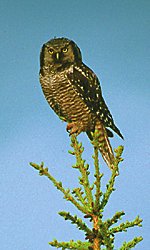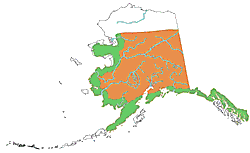Northern Hawk-Owl
Surnia ulula

Characteristics:
The Northern Hawk-Owl has a long, slender tail and a hawk-like profile. Its facial disk is bordered with black, and its underparts are barred in brown. Medium in size, the Northern Hawk-Owl is about 16” long. It is most often seen perched atop a tree at the edge of a clearing. The Northern Hawk-Owl’s flight is low and swift.
Hunting Techniques and Prey:
Unlike most other owls, the Northern Hawk-Owl hunts throughout the day, although they are most active in the early morning and late evening. They perch atop trees and watch for prey which includes a variety of small mammals and birds. Their most common prey include meadow voles, red-backed voles, lemmings, shrews, young snowshoe hares, and a variety of small birds.
Habitat:
Northern Hawk-Owls nest in open to moderately dense coniferous forests, and hunt along the forest edges, in muskegs, burned areas, and open subalpine forests. They nest on the tops of tree stubs, and occasionally in tree cavities.
Voice:
Northern Hawk-Owl Call (MP3 file 281 kB)
Courtship calls are given in late evening and early
morning from mid-February through April or May. The song is a prolonged series of short, rolling,
sharp whistles. Each call lasts at least 10 seconds and is repeated frequently. It has also been
described as a hawk-like rapid, sharp, ki-ki-ki-ki cry.

|
|
|
|
Common Uncommon |
 This information is from The Alaska Owlmanac: A guide to the identification, habits, and habitat of ten owl species found in Alaska.
The Alaska Owlmanac (PDF 1,163 kB)
This information is from The Alaska Owlmanac: A guide to the identification, habits, and habitat of ten owl species found in Alaska.
The Alaska Owlmanac (PDF 1,163 kB)
